Zicheng Zhang
Embodied Image Compression
Dec 12, 2025Abstract:Image Compression for Machines (ICM) has emerged as a pivotal research direction in the field of visual data compression. However, with the rapid evolution of machine intelligence, the target of compression has shifted from task-specific virtual models to Embodied agents operating in real-world environments. To address the communication constraints of Embodied AI in multi-agent systems and ensure real-time task execution, this paper introduces, for the first time, the scientific problem of Embodied Image Compression. We establish a standardized benchmark, EmbodiedComp, to facilitate systematic evaluation under ultra-low bitrate conditions in a closed-loop setting. Through extensive empirical studies in both simulated and real-world settings, we demonstrate that existing Vision-Language-Action models (VLAs) fail to reliably perform even simple manipulation tasks when compressed below the Embodied bitrate threshold. We anticipate that EmbodiedComp will catalyze the development of domain-specific compression tailored for Embodied agents , thereby accelerating the Embodied AI deployment in the Real-world.
Using GUI Agent for Electronic Design Automation
Dec 12, 2025Abstract:Graphical User Interface (GUI) agents adopt an end-to-end paradigm that maps a screenshot to an action sequence, thereby automating repetitive tasks in virtual environments. However, existing GUI agents are evaluated almost exclusively on commodity software such as Microsoft Word and Excel. Professional Computer-Aided Design (CAD) suites promise an order-of-magnitude higher economic return, yet remain the weakest performance domain for existing agents and are still far from replacing expert Electronic-Design-Automation (EDA) engineers. We therefore present the first systematic study that deploys GUI agents for EDA workflows. Our contributions are: (1) a large-scale dataset named GUI-EDA, including 5 CAD tools and 5 physical domains, comprising 2,000+ high-quality screenshot-answer-action pairs recorded by EDA scientists and engineers during real-world component design; (2) a comprehensive benchmark that evaluates 30+ mainstream GUI agents, demonstrating that EDA tasks constitute a major, unsolved challenge; and (3) an EDA-specialized metric named EDAgent, equipped with a reflection mechanism that achieves reliable performance on industrial CAD software and, for the first time, outperforms Ph.D. students majored in Electrical Engineering. This work extends GUI agents from generic office automation to specialized, high-value engineering domains and offers a new avenue for advancing EDA productivity. The dataset will be released at: https://github.com/aiben-ch/GUI-EDA.
GeoX-Bench: Benchmarking Cross-View Geo-Localization and Pose Estimation Capabilities of Large Multimodal Models
Nov 17, 2025Abstract:Large multimodal models (LMMs) have demonstrated remarkable capabilities across a wide range of tasks, however their knowledge and abilities in the cross-view geo-localization and pose estimation domains remain unexplored, despite potential benefits for navigation, autonomous driving, outdoor robotics, \textit{etc}. To bridge this gap, we introduce \textbf{GeoX-Bench}, a comprehensive \underline{Bench}mark designed to explore and evaluate the capabilities of LMMs in \underline{cross}-view \underline{Geo}-localization and pose estimation. Specifically, GeoX-Bench contains 10,859 panoramic-satellite image pairs spanning 128 cities in 49 countries, along with corresponding 755,976 question-answering (QA) pairs. Among these, 42,900 QA pairs are designated for benchmarking, while the remaining are intended to enhance the capabilities of LMMs. Based on GeoX-Bench, we evaluate the capabilities of 25 state-of-the-art LMMs on cross-view geo-localization and pose estimation tasks, and further explore the empowered capabilities of instruction-tuning. Our benchmark demonstrate that while current LMMs achieve impressive performance in geo-localization tasks, their effectiveness declines significantly on the more complex pose estimation tasks, highlighting a critical area for future improvement, and instruction-tuning LMMs on the training data of GeoX-Bench can significantly improve the cross-view geo-sense abilities. The GeoX-Bench is available at \textcolor{magenta}{https://github.com/IntMeGroup/GeoX-Bench}.
A Multi-To-One Interview Paradigm for Efficient MLLM Evaluation
Sep 18, 2025Abstract:The rapid progress of Multi-Modal Large Language Models (MLLMs) has spurred the creation of numerous benchmarks. However, conventional full-coverage Question-Answering evaluations suffer from high redundancy and low efficiency. Inspired by human interview processes, we propose a multi-to-one interview paradigm for efficient MLLM evaluation. Our framework consists of (i) a two-stage interview strategy with pre-interview and formal interview phases, (ii) dynamic adjustment of interviewer weights to ensure fairness, and (iii) an adaptive mechanism for question difficulty-level chosen. Experiments on different benchmarks show that the proposed paradigm achieves significantly higher correlation with full-coverage results than random sampling, with improvements of up to 17.6% in PLCC and 16.7% in SRCC, while reducing the number of required questions. These findings demonstrate that the proposed paradigm provides a reliable and efficient alternative for large-scale MLLM benchmarking.
VQualA 2025 Challenge on Visual Quality Comparison for Large Multimodal Models: Methods and Results
Sep 11, 2025

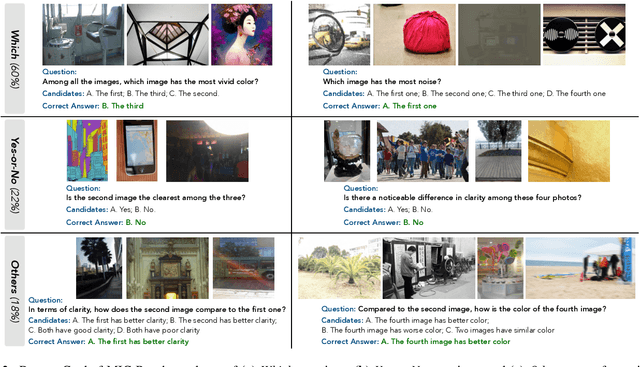
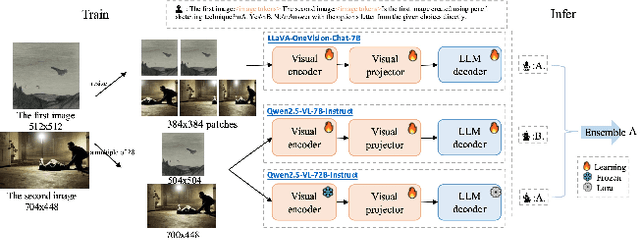
Abstract:This paper presents a summary of the VQualA 2025 Challenge on Visual Quality Comparison for Large Multimodal Models (LMMs), hosted as part of the ICCV 2025 Workshop on Visual Quality Assessment. The challenge aims to evaluate and enhance the ability of state-of-the-art LMMs to perform open-ended and detailed reasoning about visual quality differences across multiple images. To this end, the competition introduces a novel benchmark comprising thousands of coarse-to-fine grained visual quality comparison tasks, spanning single images, pairs, and multi-image groups. Each task requires models to provide accurate quality judgments. The competition emphasizes holistic evaluation protocols, including 2AFC-based binary preference and multi-choice questions (MCQs). Around 100 participants submitted entries, with five models demonstrating the emerging capabilities of instruction-tuned LMMs on quality assessment. This challenge marks a significant step toward open-domain visual quality reasoning and comparison and serves as a catalyst for future research on interpretable and human-aligned quality evaluation systems.
AU-IQA: A Benchmark Dataset for Perceptual Quality Assessment of AI-Enhanced User-Generated Content
Aug 07, 2025Abstract:AI-based image enhancement techniques have been widely adopted in various visual applications, significantly improving the perceptual quality of user-generated content (UGC). However, the lack of specialized quality assessment models has become a significant limiting factor in this field, limiting user experience and hindering the advancement of enhancement methods. While perceptual quality assessment methods have shown strong performance on UGC and AIGC individually, their effectiveness on AI-enhanced UGC (AI-UGC) which blends features from both, remains largely unexplored. To address this gap, we construct AU-IQA, a benchmark dataset comprising 4,800 AI-UGC images produced by three representative enhancement types which include super-resolution, low-light enhancement, and denoising. On this dataset, we further evaluate a range of existing quality assessment models, including traditional IQA methods and large multimodal models. Finally, we provide a comprehensive analysis of how well current approaches perform in assessing the perceptual quality of AI-UGC. The access link to the AU-IQA is https://github.com/WNNGGU/AU-IQA-Dataset.
The Ever-Evolving Science Exam
Jul 22, 2025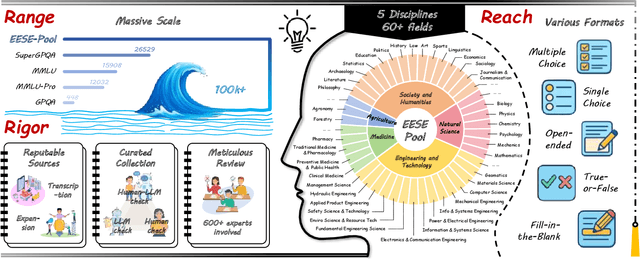
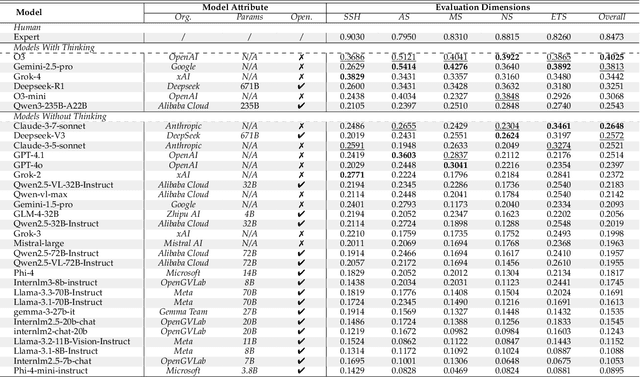
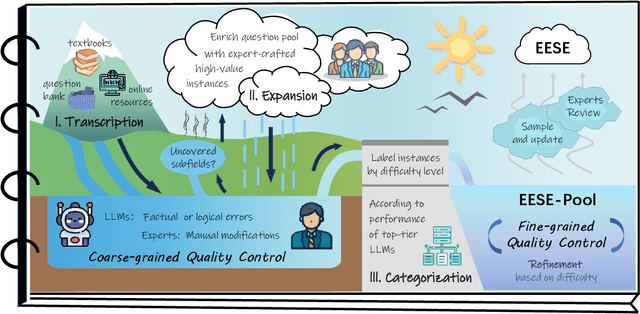
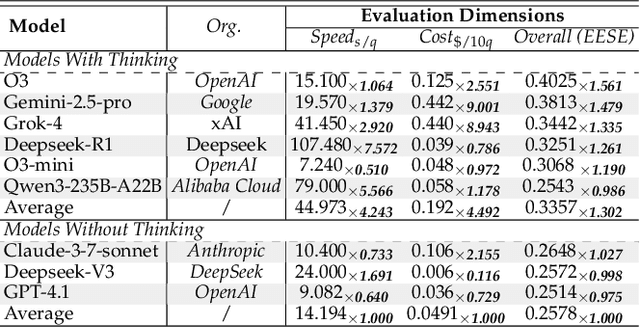
Abstract:As foundation models grow rapidly in capability and deployment, evaluating their scientific understanding becomes increasingly critical. Existing science benchmarks have made progress towards broad **Range**, wide **Reach**, and high **Rigor**, yet they often face two major challenges: **data leakage risks** that compromise benchmarking validity, and **evaluation inefficiency** due to large-scale testing. To address these issues, we introduce the **Ever-Evolving Science Exam (EESE)**, a dynamic benchmark designed to reliably assess scientific capabilities in foundation models. Our approach consists of two components: 1) a non-public **EESE-Pool** with over 100K expertly constructed science instances (question-answer pairs) across 5 disciplines and 500+ subfields, built through a multi-stage pipeline ensuring **Range**, **Reach**, and **Rigor**, 2) a periodically updated 500-instance subset **EESE**, sampled and validated to enable leakage-resilient, low-overhead evaluations. Experiments on 32 open- and closed-source models demonstrate that EESE effectively differentiates the strengths and weaknesses of models in scientific fields and cognitive dimensions. Overall, EESE provides a robust, scalable, and forward-compatible solution for science benchmark design, offering a realistic measure of how well foundation models handle science questions. The project page is at: https://github.com/aiben-ch/EESE.
The Primacy of Magnitude in Low-Rank Adaptation
Jul 09, 2025Abstract:Low-Rank Adaptation (LoRA) offers a parameter-efficient paradigm for tuning large models. While recent spectral initialization methods improve convergence and performance over the naive "Noise & Zeros" scheme, their extra computational and storage overhead undermines efficiency. In this paper, we establish update magnitude as the fundamental driver of LoRA performance and propose LoRAM, a magnitude-driven "Basis & Basis" initialization scheme that matches spectral methods without their inefficiencies. Our key contributions are threefold: (i) Magnitude of weight updates determines convergence. We prove low-rank structures intrinsically bound update magnitudes, unifying hyperparameter tuning in learning rate, scaling factor, and initialization as mechanisms to optimize magnitude regulation. (ii) Spectral initialization succeeds via magnitude amplification. We demystify that the presumed knowledge-driven benefit of the spectral component essentially arises from the boost in the weight update magnitude. (iii) A novel and compact initialization strategy, LoRAM, scales deterministic orthogonal bases using pretrained weight magnitudes to simulate spectral gains. Extensive experiments show that LoRAM serves as a strong baseline, retaining the full efficiency of LoRA while matching or outperforming spectral initialization across benchmarks.
JoyAgents-R1: Joint Evolution Dynamics for Versatile Multi-LLM Agents with Reinforcement Learning
Jun 24, 2025Abstract:Multi-agent reinforcement learning (MARL) has emerged as a prominent paradigm for increasingly complex tasks. However, joint evolution across heterogeneous agents remains challenging due to cooperative inefficiency and training instability. In this paper, we propose the joint evolution dynamics for MARL called JoyAgents-R1, which first applies Group Relative Policy Optimization (GRPO) to the joint training of heterogeneous multi-agents. By iteratively refining agents' large language models (LLMs) and memories, the method achieves holistic equilibrium with optimal decision-making and memory capabilities. Specifically, JoyAgents-R1 first implements node-wise Monte Carlo sampling on the behavior of each agent across entire reasoning trajectories to enhance GRPO sampling efficiency while maintaining policy diversity. Then, our marginal benefit-driven selection strategy identifies top-$K$ sampling groups with maximal reward fluctuations, enabling targeted agent model updates that improve training stability and maximize joint benefits through cost-effective parameter adjustments. Meanwhile, JoyAgents-R1 introduces an adaptive memory evolution mechanism that repurposes GRPO rewards as cost-free supervisory signals to eliminate repetitive reasoning and accelerate convergence. Experiments across general and domain-specific scenarios demonstrate that JoyAgents-R1 achieves performance comparable to that of larger LLMs while built on smaller open-source models.
Scaling-up Perceptual Video Quality Assessment
May 28, 2025Abstract:The data scaling law has been shown to significantly enhance the performance of large multi-modal models (LMMs) across various downstream tasks. However, in the domain of perceptual video quality assessment (VQA), the potential of scaling law remains unprecedented due to the scarcity of labeled resources and the insufficient scale of datasets. To address this, we propose \textbf{OmniVQA}, an efficient framework designed to efficiently build high-quality, human-in-the-loop VQA multi-modal instruction databases (MIDBs). We then scale up to create \textbf{OmniVQA-Chat-400K}, the largest MIDB in the VQA field concurrently. Our focus is on the technical and aesthetic quality dimensions, with abundant in-context instruction data to provide fine-grained VQA knowledge. Additionally, we have built the \textbf{OmniVQA-MOS-20K} dataset to enhance the model's quantitative quality rating capabilities. We then introduce a \textbf{complementary} training strategy that effectively leverages the knowledge from datasets for quality understanding and quality rating tasks. Furthermore, we propose the \textbf{OmniVQA-FG (fine-grain)-Benchmark} to evaluate the fine-grained performance of the models. Our results demonstrate that our models achieve state-of-the-art performance in both quality understanding and rating tasks.
 Add to Chrome
Add to Chrome Add to Firefox
Add to Firefox Add to Edge
Add to Edge